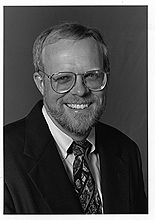
Spring/Summer 1999
Volume 6, Issue 2
Spring/Summer 1998
Volume
3, Issue 1
January 1995
Volume
2, Issue 4
October 1994
Volume
2, Issue 1
January 1994
Parallel Computing Pioneers
John L. Hennessy
Professor of Electrical Engineering and Computer Science and Dean, School of Engineering, Stanford University, California
Throughout more than two decades of teaching, conducting research, and leading groundbreaking projects at Stanford University, John L. Hennessy has developed technologies that have revolutionized the field of parallel computation His primary focus has been on building very high- performance computers and making them useful to a wide variety of potential users. His current interest is in making such systems so inexpensive that massive amounts of computer power can be applied to solve problems ranging from large-scale scientific simulations to simple sensory tasks like speech recognition.
Hennessy received his B.E. in Electrical Engineering from Villanova University (1973) and his M.S. and Ph.D. degrees in computer science from the State University of New York (SUNY) at Stony Brook ( 1975 and 1977). He joined the faculty at Stanford University in 1977 as an assistant professor of electrical engineering. By 1981, he had initiated one of the most significant projects of his career -- the MIPS high- performance Reduced Instruction Set Computer (RISC) built in VLSI. The name MIPS was chosen by the graduate students on the project as a double entendre: MIPS, meaning millions of instructions per second and MIPS, meaning microprocessor without interlocked pipestages. The latter name referred to a key design feature, namely using software rather than hardware to manage the pipeline. "The MIPS project, together with the other RISC exploration projects at Berkeley and IBM, showed that the interaction of instruction set design and computer performance could be quite important," says Hennessey. "Perhaps more importantly, the Berkeley RISC project and Stanford MIPS project demonstrated that microprocessors could compete with and even outperform minicomputers."
Hennessy also played a key role in transferring the MIPS technology to industry. During a sabbatical leave from Stanford in 1984 to 1985, he co-founded MIPS Computer Systems, which specialized in the production of computers and chips based on these concepts. He remained chief scientist with the company until 1992, when it became Silicon Graphics Computer Systems. He has been a chief architect with Silicon Graphics since that time.
In 1986, Hennessy was named professor of electrical engineering and computer science at Stanford. Currently, he is also the Frederick Emmons Terman Professor of Engineering and the Dean of Engineering. Recent research projects include the Stanford Distributed Architecture for Shared Memory (DASH) multiprocessor project. The concepts pioneered in the DASH architecture have appeared in several recent machines, including the Convex Exemplar series and the SGI Origin series. He now leads the Flexible Architecture for Shared Memory (FLASH) Project, part of the High Performance Computing and Communications (HPCC) program. FLASH explores how the architectural paradigms now used in different parallel machines might be supported in a single, flexible architecture.
This year, Hennessy and CRPC Director Ken Kennedy are two of four parallel computing experts invited to give High Performance Networking and Computing State of the Art Field Talks at SC97 in San Jose, California. Hennessy's presentation, "Perspectives on the Architecture of Scalable Multiprocessors: Recent Development and Prospects for the future," will examine the tradeoffs between the use of distributed shared memory architectures and cluster-based architectures in scalable multiprocessor systems.
Hennessy is the co-author of two leading textbooks in computer architecture and is author or co-author of more than 100 papers and technical reports. He has been active on dozens of advisory boards, conference committees, and editorial boards throughout his career. His many honors include the 1983 John J. Gallen Memorial Award, awarded by Villanova University as the most outstanding young engineering alumnus. He is the recipient of a 1984 National Science Foundation Presidential Young Investigator Award, and in 1987 was named the Willard and Inez K. Bell Professor of Electrical Engineering and Computer Science. In 1991, he received the Distinguished Alumnus Award from the State University of New York at Stony Brook. He is an IEEE Fellow, a meber of the National Academy of Engineering, a Fellow of the American Academy of Arts and Sciences, and a Fellow of the Association for Computing Machinery. He is the recipient of the 1994 IEEE Piore Award.
Table of Contents
